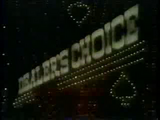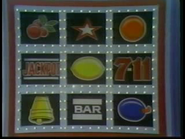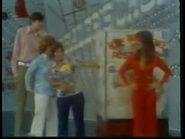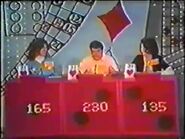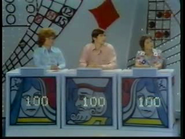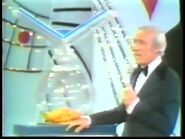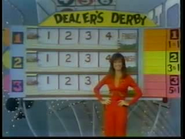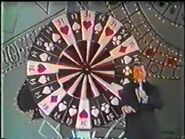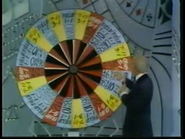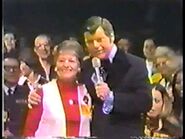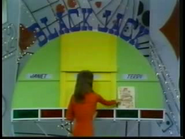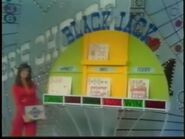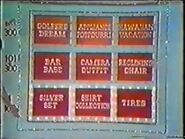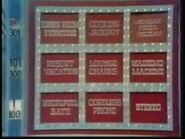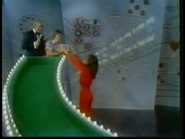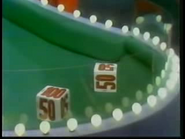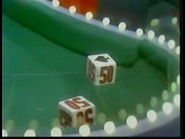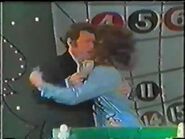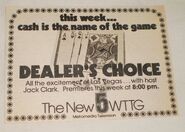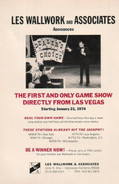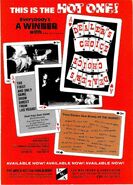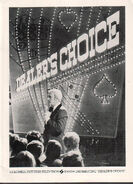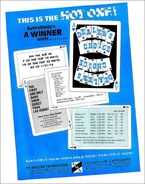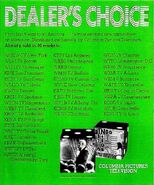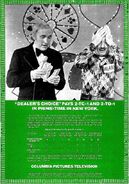| Hosts | |
| Bob Hastings (1974, first few weeks) Jack Clark (1974–1975) | |
| Hostess | |
| Jane Nelson | |
| Announcer | |
| Jim Thompson | |
| Broadcast | |
| Pilots: 8/24/1973, 9/8/1973 Syndication (Daily): 1/21/1974 – 12/12/1975 | |
| Packagers | |
| Odyssey Productions (early 1974) Fishman-Freer Productions (1974–1975) | |
| Distributors | |
| Les Wallwork and Associates (early 1974) Columbia Pictures Television (1974–1975) | |
OPENING #1: "And now, from the Tropicana Hotel in Las Vegas, it's Dealer's Choice, with your favorite dealer, Bob Hastings/Jack Clark!"
OPENING #2: "And now, it's time to place your bets on America's favorite gambling show, Dealer's Choice, with your host, Jack Clark!"
Dealer's Choice was a short-lived gambling game show.
Gameplay[]
Contestants selected from the studio audience played a series of casino games. They were spotted 100 chips to start, and they could bet as much as wanted, up to the maximum bet in each game.
Contestant Selections[]
To start, one audience member came up on stage to reveal the names of the three contestants playing that day on a nine-space, slot machine-typed game board. The game board had nine slot machine symbols: Cherries, Star, Orange, Jackpot, Lemon, 7-11, Bell, Bar, and Grape. Three of the symbols had the three contestants name's behind them, while the others had a sad face hidden. He/She had four choices and for each contestant's name revealed, the audience member won $25; and if all three contestants' names were revealed, the audience member also won a prize in addition to $75. This practice stopped after the show moved to California and the three names were revealed one by one at the call of host Jack Clark.
Home Viewer Contest[]
When Jack Clark took over the show, this, a new Home Viewer Contest was instituted. Each of the three chosen contestants drew a postcard to see who their home viewer partners were. The winner of that day's game also won a prize for that home viewer.
Main Game[]
The game was played in four rounds, each featuring a certain type of gambling game.
Round 1: Drawing Cards[]
Jane Nelson would ask a player to cut a deck of cards, afterwhich, each contestant would bet either 5 or 10 chips. Their scores were immediately deducted when they made their bets. Cards would then be drawn one at a time up to four or five, and as long as they met positive conditions, the contestants won double their bets. The game ended when all the cards were drawn, or if a bad card was drawn. When the latter happened, the contestants who still in lost their bets. So to prevent this from happening, each had an option to stop and keep their bets. If no bad card was drawn at all, the contestants kept their bets and added them to their scores.
- High/Low – The bad cards in this game were 7, 8, and 9. As long as cards lower than 7 or higher than 9 came up, the game continued up to a maximum of four or five cards. If a 7, 8, or 9 was drawn, the game was over.
- Ace/Face is Out – Aces and face cards were the bad ones. Players won their bets each time any number card was drawn.
- Any Pair Loses – So called because if any two cards matched, any players who were still playing lost.
- In Between – The bad cards here were 2, Kings, and Aces. Everything else was good.
Round 2[]
This round featured a game from one of two categories, with contestants permitted to bet up to 25 chips.
Mixing Machine[]
This mixed up ping-pong balls marked with numbers (usually 1, 2 & 3), and how many of each of those numbers determined the odds of winning the bet. Usually, it took 3-5 of the same number (or combination of numbers) to end the game.
- Speculation – The players were faced with a "Stock Exchange Board" with three stocks, each with a different number of odds determined by the number of ping-pong balls representing it (1:1 for Stock #1, 2:1 for Stock #2, and 5:1 for Stock #3). The contestants would bet on which stock would reach one point first. The hopper represented a "ticker-tape machine". For each ball drawn, the number on the one corresponding to that stock made it go up by ⅕ of a point. As soon as a stock reached the full point, the game ended and those who bet on that stock won their bet(s).
- Dealer's Derby – This was played in a horse racing format. There were three horses, each one with a set number of odds (1:1 for Horse #1, 3:1 for Horse #2, and 5:1 for Horse #3) The contestants would bet on which horse would reach the finish line first. For each one drawn, the number on the ball corresponding to one of the horses caused that horse to move one space (with five being the winning number of spaces). Those betting on the horse that finished first won their bets.
- Tropicana 500 – Same rules as Dealer's Derby, except it was played in an auto racing format. This game was only played while the show was produced in Las Vegas.
- Baseball – The players had to bet on either 4 hits or 3 Strikes coming up first. This game wasn't played often and was retired after Season 1.
- Bingo – The game was played on a 16-number grid rather than the usual 25-square grid. The players had to bet which directional bingo would occur first; either horizontal (across), vertical (up & down) or diagonal. The diagonal paid higher odds since there were only two possibilities (the others had four). Numbers on the board were drawn one at a time and as soon a "bingo" was made, the game ended; and those who bet on the right direction won their bets.
- 8 Ball – This was played in a pool format. The numbers on the balls were the ones found on a billiard ball, ranging from 1 to 15. The odds were based on how many of a certain type of ball would come up first as follows: 1:1 for three solid balls (1 to 7), 3:1 for five striped balls (9 to 15), and 8:1 for the black ball (8). This game was only played when the show was produced in California.
Wheel Games[]
These games used 24-spaced Wheels calibrated with various symbols or casino terms each with different odds. The contestants each bet on which symbol/name they thought that the wheel would stop on, and correct predictions won the bet times the set odds. There were three wheel games:
- The Mint Wheel – This wheel used card suits as symbols as follows:
- Spades – 1:1 (12 spaces)
- Hearts – 3:1 (6 spaces)
- Clubs – 5:1 (4 spaces)
- Diamonds – 11:1 (2 spaces)
- One Wheel Bandit – This wheel used slot machine symbols for its spaces as follows:
- Cherry – 1:1 (12 spaces)
- Bell – 3:1 (6 spaces)
- Orange – 5:1 (4 spaces)
- Bar – 11:1 (2 spaces)
- Wheel of Chance – This wheel used casino terms for its spaces as follows:
- Field – 1:1 (12 spaces)
- 7-11 – 3:1 (7 spaces)
- Craps – 5:1 (5 spaces)
Round 3: Blackjack[]
In this round, standard casino blackjack rules applied: get 21 or as close to it without going over, which was a bust. All 10s & face cards were worth 10, number cards were worth the numbers on them, and aces were worth 1 or 11. 50 chips was the max bet, and all blackjacks paid off at 2:1 (instead of the usual 3:2). The dealer for this game was another randomly chosen studio audience member who also had a home partner by drawing a postcard. Like normal casino dealers, the audience member dealer had to stand on 17 or more, and hit on 16 or less. Also the dealer won the players' chips that they bet should any of them lose by busting (going over 21) or by not beating the dealer. Each chip collected by the dealer was worth $1 to him/her, and his/her home viewer partner received the same amount in a gift certificate. Beating all three players also won the audience member & his/her home partner a bonus prize. Towards the end of the run, instead of winning cash, the dealer (and home partner) won a prize worth the value of the chips collected.
Round 4: Last Chance[]
Unlike the first three rounds, there were no max bets; so any player could go "all in". The bets also were written in secret.
During the Hastings era, the game involved five cards being revealed and totaled (in the home game (see below), this round was referred to as "Total Up"). In the Clark era, this was altered to use a game from the category opposite the one in Round 2.
The player with the most chips won the game, and a chance to roll the Bonus Dice. Regardless of who won, all contestants received a prize choice according to their final scores (1-100, 101-300, over 300), and (in later episodes), winners finishing with at least 500 chips received a new car. The prizes were chosen via the slot machine game board.
Bonus Dice[]
In this endgame, the winning contestant rolled a pair of dice with dollar amounts ranging from $50-$200 on them. (During the Hastings era, one side had $150 on it.) Whatever the total amount was that came up on the dice became his/hers and added to his/her running total. However, one die also had a spade, and rolling one of those lost all the money accumulated, which was why the winning contestant always had the option to stop and take the money after each spadeless roll. If the contestant could reach at least $1,000, (not only did that player get to keep the cash during Hastings' tenure, but) (s)he (also) won a bonus prize.
Music[]
John LaSalle
Inventors[]
Ed Fishman & Randall Freer
Studios[]
Tropicana Hotel, Las Vegas, NV (Season 1)
The Burbank Studios, Burbank, CA (Season 2)
KTTV, Los Angeles, CA (Season 3)
Trade Ads[]
Merchandise[]
A board game called Place Your Bets! (with a subtitle of "The home version of TV's exciting Dealer's Choice") was released in 1974 by Gamut of Games, which later produced an adaptation of The Diamond Head Game. The reason Place Your Bets! was used was because Parker Brothers had released a board game called Dealer's Choice, which involved used car dealerships, in 1972.
Of note, the box cover has many pictures of the show, including Jack Clark standing next to the original Wheel of Chance (which is also present in the game proper).
Rating[]
Trivia[]
During the closing credits, the host would give audience members the chance to win money by playing a high-low card game similar to the one described above.
Unlike most syndicated shows, which normally air in the Prime Time Access slots, most stations aired Dealer's Choice in the daytime slots; very few stations aired it in the early evening slots.
Links[]
Chuck Donegan's Dealer's Choice Page
The Game Show Home Game Home Page: Place Your Bets!
Place Your Bets! at BoardGameGeek
YouTube Videos[]
Bob Hastings
A full episode from 1974 (Liz/Dick/Linda, begins during Wheel of Chance)
Jack Clark
A full 1974 episode from Vegas (Janet/Mel/Terry): Part 1, Part 2
A full 1975 episode from Burbank (#301: Marilyn/Carolyn/Kate)
